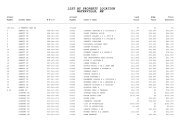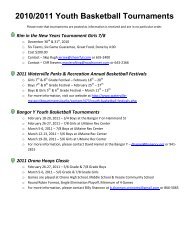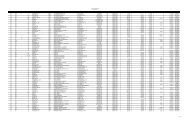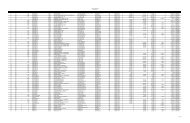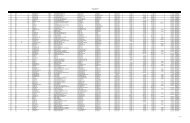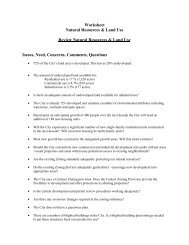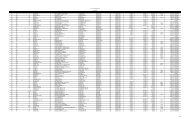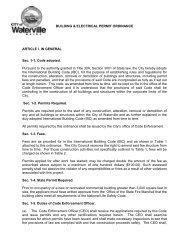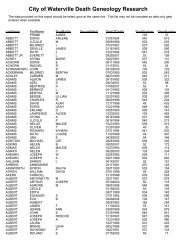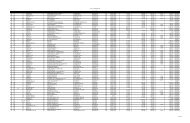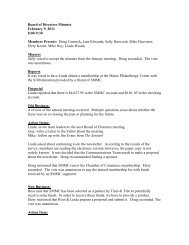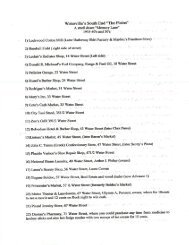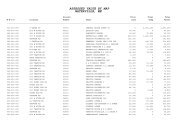Airport Master Plan 2012 - City of Waterville
Airport Master Plan 2012 - City of Waterville
Airport Master Plan 2012 - City of Waterville
Create successful ePaper yourself
Turn your PDF publications into a flip-book with our unique Google optimized e-Paper software.
If it is determined that the proposed developments impact designated farmland soils, it may be necessary<br />
to contact the U.S. Natural Resources Conservation Service (NRCS) for completion <strong>of</strong> a Farmland<br />
Conversion Impact Rating Form. Based on the impact rating score developed by the NRCS, the NRCS<br />
may recommend consideration <strong>of</strong> alternate project sites. The NRCS recognizes farmland soils are a<br />
valuable resource and evaluates the potential conversion <strong>of</strong> farmland soils in the context <strong>of</strong> regionally<br />
available farmland soils. However, the need for completing this form is contingent on the local zoning<br />
within the proposed project area since prime farmland does not include land already in or committed to<br />
urban development. Areas zoned for commercial, industrial, or high-density residential use may be<br />
exempt from this requirement.<br />
5.15 Energy Supply and Natural Resources<br />
The use <strong>of</strong> energy to support the preferred alternative would largely involve the use <strong>of</strong> additional fuels in<br />
construction and excavation machinery. The proposed airport improvement program does not require use<br />
<strong>of</strong> unusual materials in short supply; therefore, energy supplies and natural resources are not affected by<br />
the proposed airport improvement program.<br />
5.16 Light Emissions<br />
The Maine DEP recognizes the need to minimize light pollution and glare from illumination caused as a<br />
result <strong>of</strong> any development. Changes to airport lighting associated with the preferred alternative could<br />
occur as a result <strong>of</strong> the upgrade <strong>of</strong> the approach lighting system from a MALSF to a MALSR. When the<br />
<strong>Airport</strong> implements the MALSR upgrade; care will be taken to ensure that light emissions avoid<br />
unreasonable impacts to the natural environment. This includes any impacts to wildlife, contribution to<br />
artificial illumination <strong>of</strong> the night sky, hazards to drivers, and impacts to adjacent communities. It is<br />
anticipated that appropriate mitigation measures will be considered by using appropriately shielded lights<br />
and other measures.<br />
5.17 Solid Waste Impact<br />
It is anticipated that minimal amounts <strong>of</strong> solid waste will be generated from the daily operations <strong>of</strong> the<br />
proposed development. Waste disposal during project implementation will be managed separately from<br />
normal airport solid waste management operations. There will be temporary solid waste management<br />
impacts during the narrowing <strong>of</strong> Runway 14-32. Depending on the actual level <strong>of</strong> necessary obstruction<br />
removal in the <strong>Airport</strong> vicinity, low to moderate amounts <strong>of</strong> removed vegetation will be generated. It is<br />
anticipated that where possible, this vegetation be disposed <strong>of</strong> on-site through chipping, and the remainder<br />
worked into the soil, in compliance with Solid Waste Management Regulations <strong>of</strong> the state <strong>of</strong> Maine.<br />
Overall, the preferred alternative will not significantly increase long term solid waste volumes; therefore,<br />
solid wastes are not expected to be adversely affected by the proposed airport improvement program.<br />
Furthermore, it is also anticipated that the <strong>Airport</strong> will recycle pavement waste from the narrowing <strong>of</strong><br />
Runway 14-32, for use in future/concurrent airport pavement projects.<br />
5.18 Environmental Justice<br />
The development on the <strong>Airport</strong> has few <strong>of</strong>f-airport impacts. In addition, there are no known areas <strong>of</strong><br />
minority and/or low-income residents in the <strong>Airport</strong> vicinity. Therefore, environmental justice<br />
requirements as described in the U.S. Department <strong>of</strong> Transportation Order to Address Environmental<br />
Justice in Minority Populations and Low-Income Populations are not applicable here.<br />
The <strong>City</strong> <strong>of</strong> <strong>Waterville</strong> Maine<br />
Environmental Review – Page 5-8<br />
<strong>Airport</strong> Solutions Group, LLC & The Louis Berger Group, Inc. December 2011



